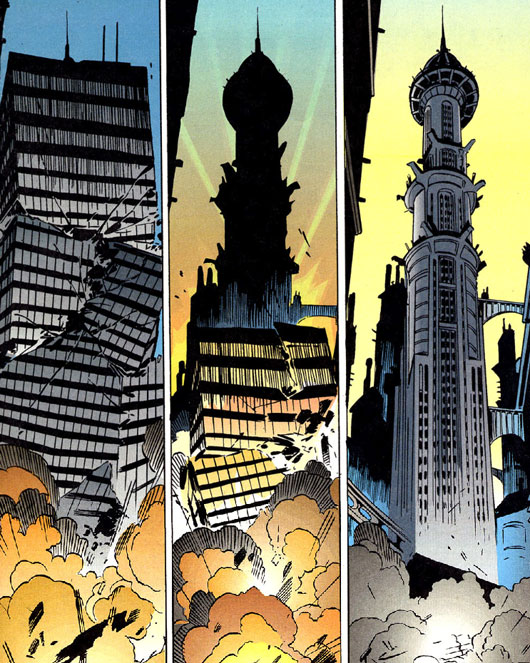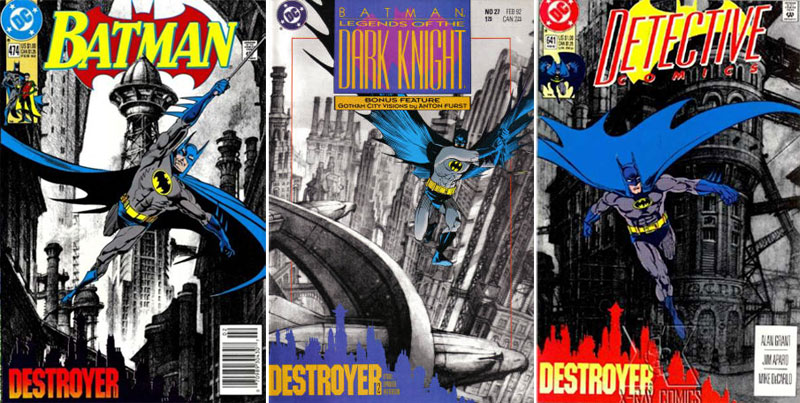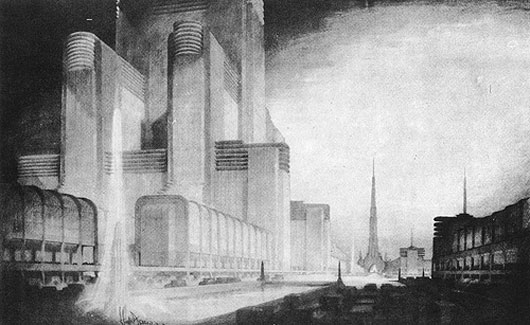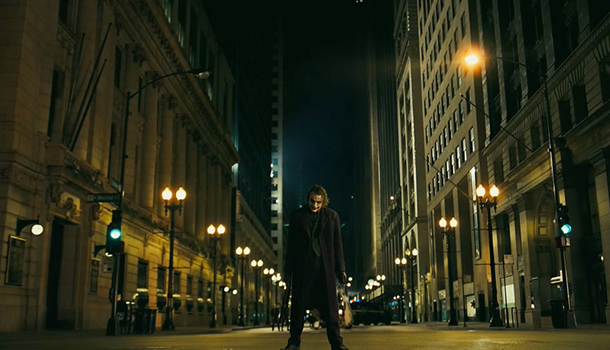New York, Dubai, Tokyo, Moscow, Gotham. Every city in every atlas—real and fictional— has a unique character shaped by history and geography. More than a mere sense of place derived from architecture and planning, cities have a feeling that pervades the consciousness of those who live there until they themselves become a piece of the urban fabric, a fractional embodiment of the city itself. Perhaps more than any other person—real or fictional—Batman is integrally linked to his city, the city he has sworn to protect. In every sense of the word, he is a true avatar of Gotham. And Gotham City itself is an avatar, not only of the dreams of its fictional architects, but of our collective urban paranoia.
One of my favorite plots in the Batman comic was a storyline titled “Destroyer” published in 1992. Written by Alan Grant, the premise is sure to please any disgruntled architect or uncompromising disciple of Howard Roark: an overzealous architecture historian/Navy SEAL bombs abandoned and derelict “soulless concrete” buildings that obscure the Neo-gothic architecture of the city’s original architect, and the subject of the mad bomber’s thesis, Cyrus Pinkney. While carefully planting explosives, our antagonist’s inner monologue is rampant with polemics decrying the conformity induced by the contemporary architecture of Gotham. “Live in a box, shop in a box, die in a box. Robots, that’s what they want. Not people. Robots that consume. Straight lines – sharp angles – square boxes. No wonder the city’s gone mad.” If there was ever a better critique of Modernism, I haven’t heard it.
As the world’s greatest detective begins to uncover the motives for the seemingly random guerilla demolitions, he discovers another Gotham, “an older city, of improbable curves and angles – a city forgotten, that had been overshadowed and buried, suffocated by the towers of the 20th century.” Suddenly, in the type of realization that can only be expressed with thought bubbles, the Caped Crusader understands the bomber’s motive. “He’s doing it…for art!”
Although it works quite well as an independent story, “Destroyer” is perhaps most notable as a lead-in to Tim Burton’s first Batman film. By aggressively redesigning the skyline of Gotham, the Mad Bomber was conveniently creating a cityscape more comparable to the Gotham envisioned by Tim Burton. Thus, when new readers, attracted by the movie, pick up a Batman comic book, the Gotham City they see on the pages resembles the Gotham of the movie. The story was really all about attracting new readers and selling more comics. And this wasn’t the last time Gotham was redesigned. Later, when the fictional city was destroyed in an earthquake, it was rebuilt as a modern glass-and-steel metropolis, paving the way for the Chicago-inspired Gotham of Christopher Nolan’s The Dark Knight, as noted by Charles Holland in his excellent article Dark Knight / White Heat: The Architecture of Gotham City.
The cover of each issue in the “Destroyer” series features a traditionally-drawn Batman swinging in front of harsh, black & white charcoal drawings of Gotham City. Drawings that channel the spirit of famed architectural delineator Hugh Ferriss, filtered through the Carcerci etchings of Piranesi. Where Ferriss eschews detail for monumentality, the renderings of Gotham City by Academy Award-winning production designer Anton Furst, are bursting with a detail and chiaroscuro that put the “goth” in Gotham, creating an unmistakably Burtonesque world: shadowy Neogothic spires dripping with gargoyles and danger. Its populace on the brink of insanity.
Since its inception, Gotham City has been presented as the embodiment of the urban fears that helped give rise to the American suburbs, the safe havens from the city that they are. Gotham City has always been a dark place, full of steam and rats and crime. A city of graveyards and gargoyles; alleys and asylums. Gotham is a nightmare, a distorted metropolis that corrupts the souls of good men. In the excellent book, Woody Allen on Woody Allen, the auteur discusses his moody, Brechtian comedy Shadows and Fog, which takes place over the course of a single night in a vaguely European village. “Once you get out in the night, there is a sense that civilization is gone. All the stores are closed, everything is dark and it’s a different feeling. You start to realize that the city is just a superimposed man-made convention and that the real thing that you’re living on is a planet. It’s a wild thing in nature. All the civilization that protects you and enables you to lie to yourself about life is all man-made and superimposed.” In other words, civilization ends at night. And in Gotham City, it is always night. In Nolan’s second Batman film, The Dark Knight (the dark night) the Joker exploits this weakness in man, the eternal fear-of-the-dark where all our self-imposed rules and behaviors are worth nothing; where man returns to a more primal nature. He wants to prove that our civility is a superficiality imposed by the constructs of society and the safety of our buildings.
In the “Destroyer” storyline we learn that the religious fanatic architect Cyrus Pinkney was hired by the equally moralist Judge Solomon Wayne, ancestor of Batman’s alter-ego, Bruce Wayne. For Solomon Wayne, a city should be a sanctuary, a fortress protecting culture and civility from the “godlessness of the wilds.” For Pinkney, Gotham needed structures to defend itself from the evil spirits responsible for corrupting man. Through a mystical epiphany, the Mad Bomber came to believe that Pinkney’s buildings literally kept “the demons” at bay. Cities have the power to affect the consciousness of its inhabitants and the ubiquitous gargoyles of the “Gotham Style” were intended to frighten people onto the path of righteousness.
Ferriss himself acknowledges such emotional and behavioral effects of architecture, writing in his book The Metropolis of Tomorrow:
“it has been our habit to assume that a building is a complete success if it provides for the utility, convenience and health of its occupants and, in addition, presents a pleasing exterior. But this frame of mind fails to appreciate that architectural forms necessarily have other values than the utilitarian or even others than those which we vaguely call the aesthetic. Without any doubt, these same forms quite specifically influence both the emotional and the mental life of the onlooker. Designers have generally come to realize the importance of the principle stated by the late Louis Sullivan, ‘Form follows Function.’ The axiom is not weakened by the further realization that Effect follows Form.”
Ferriss’s iconic and much sought-after renderings were specifically designed to communicate the emotional influence of architecture – not necessarily what the building is, but the power it has.
Through the filter of the bomber’s insanity, Batman is, ironically, seen as one of the demons corrupting the city. Indeed, as drawn in this series, Batman is a kind of expressionist demon; cloaked in shadows and violent movement of swirling of cape and cowl. But is he a demon, or is he a living manifestation of Gotham’s gargoyles? Of its stone protectors? A man shaped, perhaps unconsciously, by the gothic vaults and flying buttresses and monstrous sculptures of Cyrus Pinkney. A man who, like the city he protects, frightens the citizens onto the path of righteousness.
With his psychological origins linked to the rampant criminal behavior of Gotham, Batman is inarguably a product, an expression, of the city he lives in. But is he its demon or its savior? The duality of Batman’s effect on Gotham has been frequently debated in comics, and recently in the Nolan Batman films. Despite his noble intentions, it’s entirely possible that Batman is in fact one of the major causes of Gotham’s problems. In dressing up as a bat, he may have succeeded in instilling a primal sense of fear into the citizens of Gotham, but he’s also inadvertently inspired a new breed of criminal. Through his actions, through his very existence, he has directly influenced the rise of some of the city’s “super-villains.” Batman Begins makes this threat all too real in the final conversation between Jim Gordon and Batman:
Jim Gordon: What about escalation?
Batman: Escalation?
Jim Gordon: We start carrying semi-automatics, they buy automatics. We start wearing Kevlar, they buy armor-piercing rounds.
Batman: And?
Jim Gordon: And *you’re* wearing a mask and jumping off rooftops…
In its sequel, The Dark Knight, the Joker is constantly likening himself to Batman, showing that there may be an all-too-thin line between the criminally insane and the supposedly heroic; a duality expressed literally in the good-guy-turned-bad Harvey “Two Face” Dent and in a series of conversations between the Joker and Batman.
The Joker: Oh, you. You just couldn’t let me go, could you? This is what happens when an unstoppable force meets an immovable object. You are truly incorruptible, aren’t you? Huh? You won’t kill me out of some misplaced sense of self-righteousness. And I won’t kill you because you’re just too much fun. I think you and I are destined to do this forever.
Batman: You’ll be in a padded cell forever.
The Joker: Maybe we can share one.
and later
Batman: Then why do you want to kill me?
The Joker: [laughs] I don’t want to kill you! What would I do without you? Go back to ripping off mob dealers? No, no, NO! No. You… you… complete me.
Batman: You’re garbage who kills for money.
The Joker: Don’t talk like one of them. You’re not! Even if you’d like to be. To them, you’re just a freak…like me!
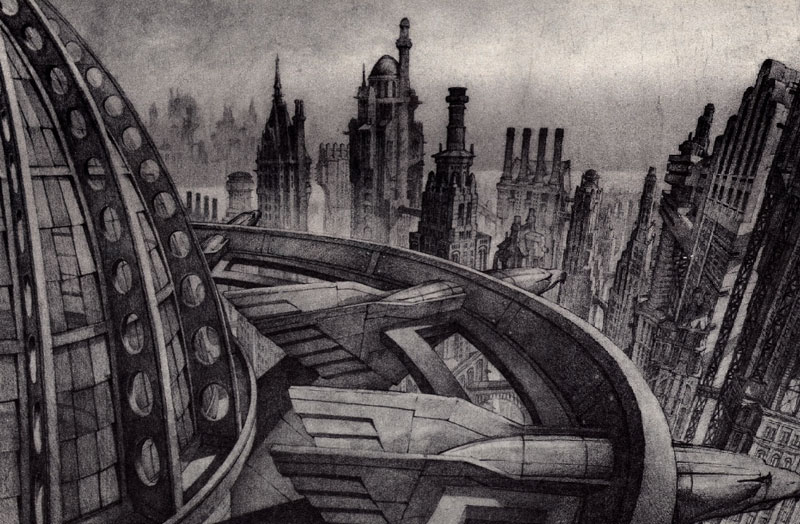
To the Joker, and probably to many people in Gotham, Batman is just the opposite side of the same coin.
“Destroyer” closes with The Mad Bomber, ex-student / historian / Navy SEAL Andre Sinclair, surrounded by police and demolition crews, shooting defiantly at a wrecking ball swinging towards him. A futile, final act in defense of the individual dream against the unstoppable assault of society’s progress. As the wrecking ball rushes towards him, his earlier thoughts echo across the scene, “man is such a temporary thing. He lives, he sins, he dies. But a city can stand a thousand years. And a dream can last forever.”
Unfortunately, the issue’s closing narration casts little hope for the nightmare that is Gotham City. “Cyrus Pinkney’s Gotham – gargoyles, to frighten people onto the path of righteousness – rounded edges to confuse the malevolent beings – thick walls to lock in virtue. The work of a madman!”
In fact, Gotham City really is the work mad men. First, a fanatically religious architect and his equally radical benefactor, who by sheer force of will and moral certitude willed Gotham into existence in the hopes that the city would, in turn, will morality into its citizens. Then, years later, the Batman has his influence. Shaped by the perverse forms of the city itself, Batman has had as much effect on the psyche of Gotham as the spires and gargoyles of the city’s architect. Like Gotham, Batman is an indeal, a force of nature, an effect. But what effect is he having? Bruce Wayne’s ancestor realized too late that he may actually be responsible for the criminal fate of Gotham City. “I wished to lock evil out of men’s neighborhoods and hearts,” Solomon Wayne lamented on his deathbed. “I fear that instead I have given it the means to be locked in.” Let’s hope that his descendant doesn’t have the same regret.
So what came first, the city or the crime? the hero or the villain? The architect or the city?
In closing, another quote from Hugh Ferriss seems appropriate:
“The contemplation of the actual Metropolis as a whole cannot but lead us at last to the realization of a human population unconsciously reacting to forms which came into existence without conscious design. A hope, however, may begin to define itself in our minds. May there not yet arise, perhaps in another generation, architects who, appreciating the influence unconsciously received, will learn consciously to direct it?”
Related Content:

